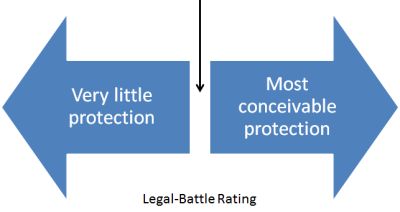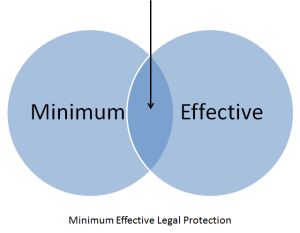I’ve often had clients ask me to keep their contracts short and simple. That’s a great goal, especially since two of the purposes of a written contract involve informing the parties about their business relationship. The less accessible a contract is to the people who need to read it, the less helpful it’ll be.
Another purpose of a written contract, though, involves ensuring that your rights are as secure as possible if you have to fight for them. That means being clear about what your rights are, providing for effective remedies if you find yourself in a legal battle, and making sure that you’re made whole after the dust settles. It also means that dotting every i and crossing every t will be especially important.
The purpose or purposes that predominate in a particular business deal will affect how complex the written contract that memorializes the deal should be. Let me suggest a framework for thinking about how to ensure the appropriate level of legal protection.
Legal-battle rating
Contracts that are rated for legal battle — and individual clauses that are rated for legal battle — will be longer, more detailed, and more complex.
Think about the “legal-battle rating” as a continuum from very little protection on the left extreme to the most conceivable protection on the right. As you move from left to right, you’ll cross “minimum effective legal protection.” This concept can be applied both to contracts as a whole and to individual clauses.
 Some contracts will never be enforced, no matter the circumstances. Some clauses in a particular contract will never be enforced, no matter the circumstances, even if other clauses in the contract might be. It would be acceptable for those contracts — and those clauses — to have a legal-battle rating that is lower than minimum effective legal protection.
Some contracts will never be enforced, no matter the circumstances. Some clauses in a particular contract will never be enforced, no matter the circumstances, even if other clauses in the contract might be. It would be acceptable for those contracts — and those clauses — to have a legal-battle rating that is lower than minimum effective legal protection.
For all others, it’s prudent to ensure that the legal-battle rating exceeds minimum effective legal protection.
Minimum effective legal protection
So what is minimum effective legal protection? It’s legal protection that’s effective under the circumstances. It’s also the minimum legal protection that’s necessary under the circumstances.

Picture the universe of contract provisions that could be used to cover a concept in a particular contract and that would provide effective legal protection. Now picture the universe of less-than-full contract provisions that could be used. Minimum effective legal protection will be the overlap of the two, as pictured in the diagram to the left. (I’m indebted to Roger Rappoport for the diagram’s concept.)
Tradeoffs for increasing the legal-battle rating
There are costs associated with increasing a contract’s legal-battle rating. From the perspective of a business that’s preparing the first draft of a contract, business and legal personnel have to take time to drill down into the details of the proposed deal to determine what’s important. And and they’ll need to work together to draft and review contract language to deal suitably with the issues that are identified as being important. This takes time, money, and company resources.
Once the contract has been sent to the opposing side, additional time will be required for negotiating the important points. Where an issue is unimportant, a business can be less adamant about making sure it’s covered adequately in the contract, but important issues require a persistence that can prolong negotiations, slow down the deal, and increase the transaction costs.
The resulting contract will most likely be longer and more complex, making it more difficult for business and legal personnel to quickly read the contract to learn the details of the legal relationship between the parties. There is increased likelihood that business people (and their attorneys for that matter) won’t fully understand the legal relationship when a contract is long and complex, and there’s less likelihood that attorneys and business people will fully discuss each of the details of the arrangement. This decreased understanding of the agreement decreases the utility of the contract for informing the parties about their business relationship and increases the likelihood that the parties will operate contrary to the requirements of the agreement.
These tradeoffs are acceptable when a business deal requires a contract with a high legal-battle rating or when there’s little utility under the circumstances in using the contract to inform the parties about their business relationship. But in other circumstances, the extra protection isn’t worth the cost.
What do you think? Are legal-battle rating and minimum effective legal protection useful concepts for thinking about how to ensure the appropriate level of legal protection in a contract?


Brian,
I am not fully convinced that focus on legal protection, means breeding complexity, costs and prolonged negotiations.
The principle is understanding the relationship, context in which the transaction takes place and trying to anticipate potential changes (risks and opportunities). Anything else may be bells and whistles or belts and suspenders to increase the apparent level of legal protection.
@briclawyer
Gaston: Very true. Still, trying to think through various future scenarios and accounting for them in a contract breeds complexity even if done well. Not all transactions warrant the same level of complexity.
I’m still mourning the loss of some great comments to this post — the result of my being my own webmaster.
I agree with you Brian… usually clients want a “good enough” agreement while us lawyers want a bullet-proof document… this because we’re trained to think of what can go wrong and, being honest, everything has the potential of going wrong.
Sometimes the difficult part is defining what is exactly that “minnimum-effective” legal protection, isn’t it?